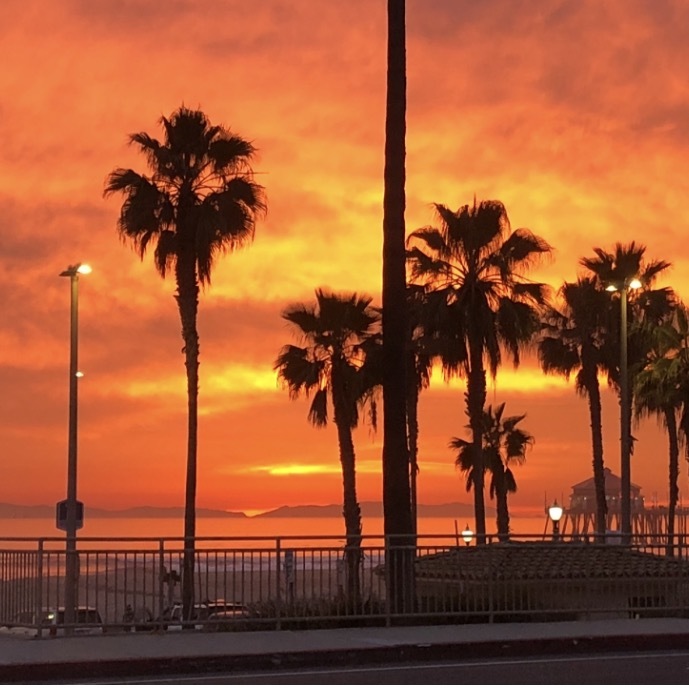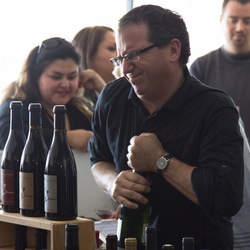Three (3) Floyds Brewing Co.
Rene Rostaing
Ampodium Côte-Rôtie Syrah 2010
2010 was a very good vintage in Rhône. Rostaing is a well know producer with people that know and drink Northern Rhône wines, not so much with others that do not. The Ampodium is the entry level into Rene & Pierre Rostaing wines. It is a blend of 13 vineyards in Northern Rhône. They are simply one of the very best producers in the region. I spent an afternoon with Rene & his son Pierre tasting in the their cellar and in their La Landonne vineyard as shown in the photos. The 2010 is drinking beautifully with many good years ahead. On the nose; ripe & slightly stewed/baked fruits of; blackberries, dark cherries, strawberries, creamy raspberries, stewed plum, black raspberries, cherries, steeped fruit tea, dry crushed rocks, iron pan, some white & black pepper, bacon fat, grilled savory meats, pork, black licorice, black cherry cola, decayed & fresh red florals with violets. The body is round and medium full. The tannins round, still a little chewy & around 55% resolved. The length, texture, tension and balance are in near perfect harmony. The fruits are; round, ruby & ripe; slightly stewed/baked fruits of; blackberries, dark cherries, strawberries, creamy raspberries, stewed plum, black raspberries & cherries. Steeped fruit tea, dry crushed rocks, chalky minerals, iron pan, coffee grounds, spice, some baking spices w/hints of vanilla, white & black pepper, drying blood, dry herbs/bay leaf, dry stems, moderate levels of bacon fat & pork, grilled savory meats, black licorice, black cherry cola, decayed & fresh red florals with fresh violets for days. The acidly is round and dripping. The long finish is plush, velvety delicious and lasts & lasts. In good vintages, I would put this in blind with the best of of the best new world wines from any vintage that many love; SQN, Booker, Saxum, Alban, Cayuse, Horsepower etc.. I’d bet most of you would pick it over these producers that cost much more $$$. It’s simply one of the best pound for pound wines/producers for this varietal. Especially, for the $$$. Wow, what a wine for the $. $55 upon release. Photos of; Winemaker Pierre Rostaing and our group in their La Landonne vineyard, the small sign that barely identifies their Estate, an example of the Quartz mineral that runs throughout their La Landonne vineyard and the view back onto the river from the top of the very steep La Landonne Vineyard. Producer notes and history...Rene Rostaing produced their first wine in 1971. However, it took almost three decades before wine became a full time occupation for Rene Rostaing. Domaine Rene Rostaing came about through marriage. The wife of Rene Rostaing was the daughter of the famed Cote Rotie grower, Albert Dervieux, and the niece of Marius Gentaz-Dervieux who gave Christine the vineyard land that became the Northern Rhone estate for Rene Rostaing. Through inheritance from Albert Dervieux Thaize (his father-in-law) who retired in 1990, and from Marius Gentaz Dervieux, his uncle, Rene Rostaing expanded his holdings, giving him some of the best terroir in Cote Rotie. The new vineyard land was basically 3 small parcels in the La Landonne, Cote Brune and Vialliere lieux-dits. This initial expansion from his initial tiny parcel, allowed Rene Rostaing to change careers and become a full time vigneron. Since 2007, the estate has managed by Pierre Rostaing, (son) of Rene Rostaing. Currently Rene Rostaing owns 7.5 hectares of vines that is spread out among 20 different parcels located in 14 locations. Perhaps the most celebrated vines of Rene Rostaing are the 1.6 hectares of vines they own in the La Landonne vineyard (photo). On La Landonne, the vines are more than 60 years old. Some vines are even close to 100 years of age! Those are his largest holdings. The smallest vineyards of Rene Rostaing are located on Cote Blonde. Rene Rostaing also has vines planted in; Fonjean, La Vialliere, Le Plomb, Bouchare, Leyat, La Roche and La Tupin. Their oldest vines are more than 70 years old and are used for Rene Rostaing Cote Blonde. The majority of those plantings are on the steep hillsides with mica, schist and rocky soils. 25% of those vines are closer to the bottom of the slopes and on the flats. Rene Rostaing remains a traditional Cote Rotie producer who is not among the last to harvest. His wines are aged using very little new, French oak barrels. On average, Rene Rostaing Cote Rotie are aged in about 10% new French oak barrels. Rene Rostaing produces 4 different Cote Rotie wines. Rene Rostaing Ampodium, which was previously known as Rostaing Cuvee Classique, is a blend of 13 sections of different vineyards, but it does not include their best holdings on La Landonne or Cote Blonde. The fruit for Rene Rostaing Ampodium has at least 40% or more of the stems removed and run between 12-13.5% abv. The wine is usually made from 100% Syrah and is aged in an average of 15% to 25% new, French oak barrels. The amount of new oak can be less, depending on the character of the vintage. About 1,750 cases are produced each year. The wine is no longer called Cuvee Classique, the name was changed to Rene Rostaing Ampodium with the 2009 vintage. Rene Rostaing La Landonne comes from a terroir consisting of sands with iron oxide and traces of quartz. This wine is always produced from 100% Syrah. The grapes are partially destemmed, with about 10% to 20% of the stems removed, depending on the vintage. There are vintages when no destemming takes place. The remainder of the grapes are whole bunch fermented in stainless steel vats. Rene Rostaing is not a believer of using too much new oak for the aging, which on average uses 10% new, French oak barrels and the remainder of the harvest is aged in demi-muids (600 liter) and French oak barrels. This wine is like most wines from La Landonne, masculine and meaty in character, requiring at least a decade to soften and develop. On average, Rene Rostaing La Landonne produces less than 600 cases depending on what the vintage delivers. Rene Rostaing Cote Blonde is perhaps his best. It’s produced from a blend of 95% Syrah and 5% Viognier. The grapes are co-fermented. The vineyards is planted in the region call Arzel. Arzel is a poor, mineral laden soil with deposits of Silex and Mica on a steep hillside. The vines are more than 50 years of age. The grapes are partially destemmed…35% to 50% of the stems are removed. The remainder of the grapes are whole bunch fermented in stainless steel vats.
The remainder of the harvest is aged in demi-muids. This one is the hardest to find and most collectible of all their wines. In fact, they only produce close to an average of 350 cases of Cote Rotie in most vintages. Rene Rostaing Cote Brune made its debut with the 2013 vintage. The vines were once part of the holdings of Marius Gentaz, which eventually passed to Rene Rostaing. Rostaing replanted those vines in 2000. Made from 100% Syrah. — 8 years ago
Bedrock Wine Co.
California Syrah 2020
This recently released 2020 Blend of Syrahs from historic vineyards across California is a rich purple in the glass, doesn’t open with much of a nose, and delivers a smooth, rich mouthfeel with hints of violet and a little oak. Maybe not the greatest of vintages for this wine but still an easy drinking wine and a great value at +/-$25. Update 3/25: Some three years later this has developed nicely with a big nose of dark fruit and underbrush, and a palate with similar fruit, earth, minerality and maybe a hint of licorice. Increased rating. — 4 years ago
Three (3) Floyds Brewing Co.
Zombie Dust Undead Pale Ale
On tap. One of the original greats. Dank, juicy, crunk. #threefloyds #paleale — 8 years ago
Domaine Leroy
Bourgogne Pinot Noir 2015
On the nose, nicely concentrated wild dark berries, black plum, notes of blue fruits, vanilla, understated cinnamon, soft, warm spices, Christmas cake and fresh dark, fragrant florals. The mouthfeel is rich & concentrated. The fruits dark are clearly fresh & ripe. Wild dark berries, black plum, plum, dark cherries, poached strawberries, black raspberries, Thompson raisins, light vanilla, soft warm spices, limestone minerals, grainy/silky chalkiness, dark moist soils, crushed rocks, violets, fresh dark florals, touch of mint, beautiful round acidity and amazing long rich beautiful finish that is well balanced fruit & earth. This is a vintage (even though Bourgogne) will cellar around 20 years. My rating could jump 2-3 points with proper storage years in the cellar. It's tasting more like 1st Cru than village wine. Photo tour of the estate, open top fermenters (I believe they ferment all their lots separately) and Lalou Bize-Leroy singing and talking to her precious vines. Producer history and notes...Domaine Leroy is arguably producing the greatest red Burgundy wines in the Cote d`Or at present. Lalou Bize-Leroy started out as a négociant, working for her family's Maison Leroy, which was founded by her father Henri. There are three parts to the Leroy empire; the Maison Leroy based in Auxey-Duresses, Domaine d’Auvenay and substantial holdings in Vosne-Romanée. Lalou Bize-Leroy also owns 25% of Domaine de la Romanée-Conti, where she was co-director until the other shareholders ousted her in 1992, partly because she had started a competing winery. Domaine Leroy has been farmed biodynamically from the start and is now certified by ECOCERT. The other exciting, if not controversial, move was the change in training system for the vines. For some time previously the hedging (rognage) of the vineyards had been done by hand rather than more abrasively by machine. However, it is not natural for the vine to be cut back as it affects the vine’s performance both in the current season and the following year. So now, after the flowering, when the shoots are lengthening, they are curled over instead of being cut back. This minimises entrecoeurs and second crop bunches forming, as well as leaving the vine happier and healthier. She also talks and sings to her vines daily. She believes this promotes health of the vines and who could argue with her given what she puts in the bottle. Lalou Bize-Leroy has 23 hectares of vines, mostly Premier and Grand Cru classified. In the vineyard, Lalou practices biodynamism as well as severe pruning and crop-thinning. The result is ridiculously low yields. Yield arguments at DRC were also an issue in her departure. You want to buy this wine. $39.99 at K&L Wine Merchants on pre-arrival. Just bought four bottles.
— 8 years ago
Three Wine Company
Spinelli Vineyard Mataro 2012
Dark and thick. Inky dark fruit, blackberry, menthol, black plum skin, bramble, some oak. Tannins sit on top of the tongue. Acidity trickles down the side. There’s an initial tartness, maybe the black plum skin. The menthol and wood notes creep in with leather emerging. Blackberry and bramble round out the flavor. This is the best I’ve had from 3 Wine Co. — 5 years ago
Three (3) Floyds Brewing Co.
Dark Lord Russian Style Imperial Stout
Thank you to my good friend Andy Bunch for bringing this beer to try tonight. A rare treat for sure. Took a while to open up, bit man, it’s hitting its stride a couple hours later with notes of semi sweet chocolate, espresso liquor, brownie batter, vanilla, toasted nuts and almond oil. A rich brew with a 15%+ ABV. Black as old motor oil and super mouth coating. Yum yum yum. — 7 years ago
Three (3) Floyds Brewing Co.
Gumballhead American Pale Wheat Ale
Very hoppy but still refreshing. — 9 years ago
Three (3) Floyds Brewing Co.
Blot Out The Sun Imperial Stout
Cellared 1 year. Incredible, 3 floyds does it again — 9 years ago







Elyse King
Les Cassagnes de La Nerthe is produced in the Southern Rhône Valley in France by a property owned by the Richard family, who also manage the famed Château La Nerthe in Châteauneuf-du-Pape. The same team creates this elegant and fruit driven wine.
The wine is a blend of organic Grenache, Syrah and Mourvèdre grapes grown in sandy and limestone soil containing shards of calcareous rocks, providing high quality natural filtration. The average age of the vines is over 40 years old. The vineyards are located at altitudes up to 600 feet above sea level. The gently undulating slopes produce high quality grapes that turn into fleshy and balanced wines. The grapes are harvested by hand and carefully sorted after arriving at the winery. The grapes are lightly crushed, and color and tannins are gently extracted with several daily pumping overs of the tanks. Co-fermentation of the three varieties occurs over a long maceration (3 to 4 weeks). The final blend is aged on fine lees in stainless steel tanks for 9 months before bottling. — 3 years ago